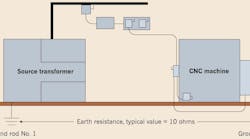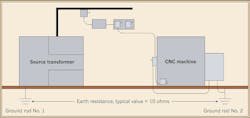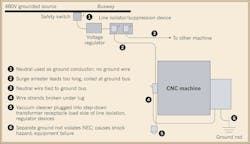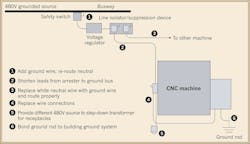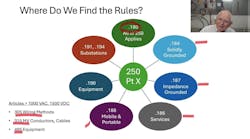Understanding the Differences Between Bonding, Grounding, and Earthing
The importance of bonding and grounding in commercial, industrial, and institutional buildings cannot be overstated. The grounded circuits of machines need to have an effective return path from the machines to the power source in order to function properly. In addition, non-current-carrying metallic components in a facility, such as equipment cabinets, enclosures, and structural steel, need to be electrically interconnected so voltage potential cannot exist between them. The benefits for the building owner are many — maximized equipment protection, elimination of shock hazard potential, increased process uptime, and reduced costs through avoiding expensive machine servicing. However, troubles can arise when terms like “bonding,” “grounding,” and “earthing” are interchanged or confused in certain situations.
Earthing is the attachment of a bonded metallic system to earth, typically through ground rods or other suitable grounding electrodes. The NEC prohibits earthing via isolated ground rods as the only means of equipment grounding. Nevertheless, some manufacturers of sensitive machinery actually encourage this practice in their installation manuals, in order to reduce “no problem found” service calls associated with machine errors and rebooting.
An Illustration
Understanding the differences between bonding/grounding and earthing is best illustrated with an example. A manufacturer of molded components was replacing failed printed circuit boards in a computerized numerically controlled (CNC) machine. After a thunderstorm, the machine's self-diagnostic system occasionally registered a component problem. The machine would not start, delaying the day's production cycle. Plant electronics technicians identified and replaced failed circuit boards, then returned the CNC machine to operation. However, each occurrence cost thousands of dollars in repairs and lost production.
Called upon to rectify the problem, personnel from the engineering services organization of a major electrical distribution equipment manufacturer observed that although the plant had grounded the CNC machine in accordance with the manufacturer's installation manual, the ground was in clear violation of the NEC. This apparent contradiction demonstrates a disturbing fact: Some grounding practices that are designed to decrease data errors in sensitive machines can actually violate grounding codes and standards, causing equipment damage and introducing safety hazards. It's also important to note that the conflicting requirements can be overcome, but never by compromising employee safety.
Key Concepts and Terms
Understanding the difference between bonding/grounding and earthing requires implicit understanding of several important concepts and terms, including those outlined below.
Safety Grounding and Machine Operation
The problem experienced by the plant in the example is not uncommon. Manufacturers of sensitive machines have discovered that isolated ground rods can decrease the number of nuisance problems, such as rebooting, data errors, and intermittent shutdowns. This decrease is due to the reduced amount of voltage transients or “noise” on the ground rod, as compared to a common building grounding system. Because of the reduction in data errors attributed to the ground rod, some manufacturers include isolated ground rods in their installation instructions. Some even imply the machine warranty will not be honored if the ground rod is not installed.
During thunderstorms or ground faults, however, an isolated ground rod becomes a liability, creating shock hazard potential for employees and high potential rises on sensitive machine components. Figure 1 illustrates the extremely large transient voltages that can develop between driven ground rods due to lightning currents and earth resistance. Although ground faults in the machine itself may not draw enough current to trip overcurrent protective devices, they can create touch hazard potential for employees.
Article 250.54 of the 2008 NEC specifically prohibits the use of isolated ground rods, or earthing, as the sole means of equipment grounding, although some have used other sections of the NEC to justify this practice. The “NEC Handbook” provides the following commentary associated with Art. 250.6 (Objectionable Currents):
“An increase in the use of electronic controls and computer equipment, which are sensitive to stray currents, has caused installation designers to look for ways to isolate electronic equipment from the effects of such stray circulating currents. Circulating currents on equipment grounding conductors, metal raceways, and building steel develop potential differences between ground and the neutral of electronic equipment.
“A solution often recommended by inexperienced individuals is to isolate the electronic equipment from all other power equipment by disconnecting it from the power equipment ground. In this corrective action, the equipment grounding means is removed or nonmetallic spacers are installed in the metallic raceway system contrary to fundamental safety grounding principles covered in the requirements of Art. 250. The electronic equipment is then grounded to an earth ground isolated from the common power system ground. Isolating equipment in this manner creates a potential difference that is a shock hazard. The error is compounded because such isolation does not establish a low-impedance ground-fault return path to the power source, which is necessary to actuate the overcurrent protection device.”
Bonding/Grounding vs. Earthing
Isolated connections to earth are not required for sensitive machine operation. Issues crop up when equipment bonding/grounding and earthing are confused. In the United States, the term “grounding” is used to refer to at least five or more grounding-related systems, including:
• System Type. This refers to the means by which power source voltage relationships are established. Power sources fall into four general categories: Transformers, generators, electric utilities, and static power converters. These systems may be configured as wye or delta, and the means by which they are interfaced with the grounding system determines the system type. The most common 3-phase system type is the solidly grounded wye, which is established by connecting a properly rated conductor (also known as the main or system bonding jumper) from the X0 terminal of the source (usually a transformer) to the grounding system.
• Equipment grounding (bonding). The best means of equipment grounding is to route a grounding conductor, suitably sized, along the same route as the power and neutral conductors, from source to machine. The NEC does allow use of metallic conduit and other substitutes, but some industry experts believe these systems are less effective and should be avoided.
• Grounding electrode (earthing). This term refers to the method by which the facility grounding system is connected and referenced to earth. The most common grounding electrode for small facilities is a metallic ground rod, but earthing systems for larger buildings can — and should — be more elaborate and include the means by which to inspect and test these systems periodically. A grounding electrode system that is buried in earth or encased in concrete and then forgotten is often the source of increasing problems as the building ages and the grounding electrodes deteriorate.
• Lightning abatement. Some facilities use air terminals (also known as lightning rods) to direct lightning strikes away from power equipment, but these devices are often connected to the grounding system in such a way that they have the opposite effect — unintentionally bringing lightning energy into facility structural steel, low-voltage transformer windings, and, subsequently, sensitive building loads.
• Signal-reference grounding. Sensitive electronic machines rely on the grounding system for reference of low-magnitude signals. Therefore, it’s often crucial to provide multiple grounding paths, rather than rely on a single equipment grounding conductor between the power source and the sensitive load. This ensures that spurious voltages on the grounding system are maintained well below the level at which they might be confused with sensitive machine reference signals. The best guide for signal-reference grounding is IEEE Standard 1100-2006, “Recommended Practice for Powering and Grounding Electronic Equipment.”
Note that earthing is not required for sensitive machine operation. Modern aircraft, for example, are packed with sensitive computers and electronic devices, which operate correctly without an attachment to earth. They rely on a bonded metallic system — the airplane framework, skin, structural supports, raceways, and grounding conductors — to serve as the ground reference. If this bonded system rises in voltage with respect to earth, all machines onboard experience the increase together. The net result is that the machines see no voltage potential differences with respect to each other. Once the airplane lands, any voltage potential between the plane and earth must be discharged by an electrode that bypasses the rubber tires.
Resolving the Issue
The immediate solution to the example plant's illegal ground rod (Fig. 2) was to remove the shock hazard. This was done by connecting a grounding conductor (1/0 copper) from the ground rod to the nearest part of the building grounding system — in this case, the structural steel. This connection eliminated the shock potential during storms by reducing the resistance between the ground rod and the building grounding system.
The next step was to eliminate the wiring errors and install a ground wire from the source to the CNC machine (Fig. 3). The primary reason that the isolated ground rod was effective in decreasing operating problems was the building's bonded system experienced voltage transients, imposed on it due to wiring errors. One common error is the improper connection of neutral wires to ground buses or ground wires to neutral buses. This error allows neutral currents to flow on the bonded system, thereby creating voltage transients. Neutral wires are only allowed to be connected to the bonded system at a service entrance or at a step-down transformer (called a separately derived source by the NEC). Notice in Fig. 2 that the plant had installed both a voltage regulator and a noise suppression device ahead of the CNC machine. These devices are often applied to solve the nuisance operating problems brought on by ground system transients. Suppression devices are not a cure-all, however. In fact, they're sometimes unnecessary when wiring and grounding problems are corrected first.
Once the spurious ground rod had been connected to the rest of the bonded system, operating issues had to be addressed, which involved correcting the wiring errors identified in the site survey. For the example facility, these steps were adequate. For other situations, you should refer to the following checklist:
1. Connect the ground rod to the bonded system and install a grounding conductor from the power source to the sensitive load to eliminate the safety hazard and allow an effective ground-fault return path.
2. Correct wiring and grounding errors on the power system serving the sensitive machine.
3. Install a step-down transformer (i.e., a separately derived source) to serve only the process machine. Derive a new neutral to the ground bonding point at the load side of the transformer.
4. Any remaining operating problems are probably caused by communications ground loops. Ground loops, which are introduced by communication wiring between sensitive machines fed from different power sources, may require more elaborate correction schemes, such as optical isolation.
Taking the Next Step
In summary, the plant in the example had installed a CNC process machine in accordance with the manufacturer's recommendations. Unfortunately, those recommendations included the requirement for a separate ground rod to serve as the only means of equipment grounding. While this practice may reduce data errors in sensitive process machines, it violates the NEC, creates a shock hazard for employees, and causes a potential difference that may damage sensitive electronic components.
Electrical engineers and contractors can help customers avoid situations like this by providing proactive counsel in this area. The best place to start is to gather as much information as possible — from the 2008 NEC, seminars/conferences, trusted electrical equipment manufacturers, and online sources. With that knowledge in hand, you have yet another reason to call on a customer and resolve an issue of critical importance.
Ray, P.E., is director of Schneider Electric's Square D Engineering Services, Raleigh, N.C. He can be reached at [email protected]. Waterer is an Engineering Fellow for Schneider Electric's Square D Engineering Services, Norcross, Ga. He can be reached at [email protected].
Sidebar: Knowledge is Power
An electrical engineer or contractor who understands the various elements of proper grounding, bonding, and earthing systems is best positioned to counsel customers on appropriate practices in this area. A keen understanding of NEC requirements could also help you develop a reputation as being the one to contact with any bonding/grounding-related questions. Such expertise could also lead to future business.
